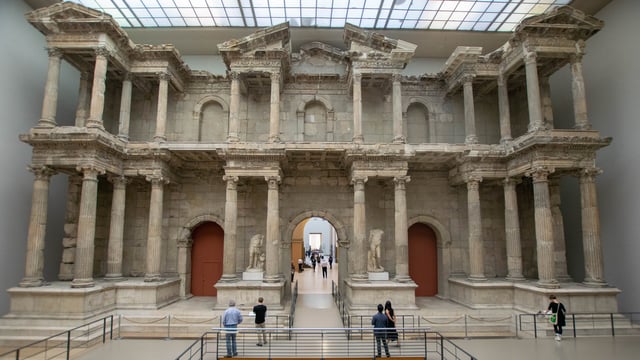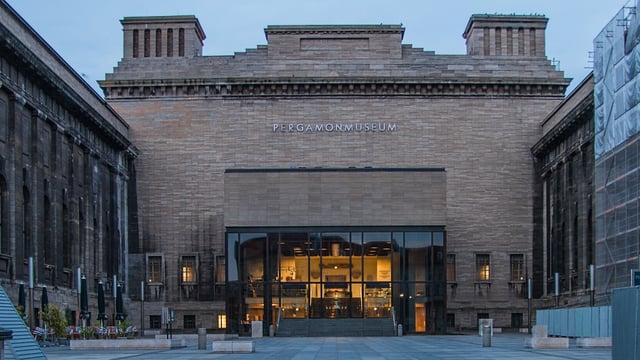The Market Gate of Miletus is one of the most well known pieces of Roman architecture. The large marble monument is now housed in the Pergamon Museum on Museumsinsel in Berlin, Germany. The marble gate was built in the town of Miletus in the 2nd century AD during the reign of Emperor Hadrian. After various stages of restoration and renovation, the structure was ultimately destroyed during an earthquake sometime at the beginning of the second millennium. In 1903 it was excavated by a German team of archaeologists and take to Berlin, where in the 1920s it was reconstructed in the Pergamon Museum. Following severe destruction during World War II it underwent lengthy periods of restoration and finally reopened to the public in November 2008.
- Thomas Dowson
- Last Checked and/or Updated 3 April 2023
- No Comments
- Amazing Artefacts, Berlin, Photo Essays
Have you ever visited a museum hoping to see a particular object only to find a note informing you it is has been temporarily removed for some or other reason? Or, even worse, that the whole gallery is shut? Each time I had visited the Pergamon Museum before January 2014, the gallery with the Roman market gate from Miletus in Turkey had been closed. If I am honest though, I did not really know what I was missing.
During my visit to the Pergamon Museum in January 2014 I was walking from the Pergamon Altar gallery (now closed until at least 2027) into the Roman Architecture gallery, seeing the market gate took my breath away. Literally. Partly because this is no ordinary Roman monument. And I was not expecting anything quite so monumental.


A History of the Miletus Market Gate
This magnificent market gate from Miletus, in present day Turkey, was built during the Roman period sometime in the second century AD – probably during the reign of Emperor Hadrian. It was donated to the city by a wealthy Roman citizen, but his name has not survived.
More reminiscent of the façade of a theatre stage or a library than a gate, the extravagant structure decorated one of the most important public squares in the the city and formed a passage to the the city’s southern market square. Later, between the 6th and 8th centuries, the gate became incorporated into the city’s fortifications. But in the 10th or 11th century the gate was reduced to a pile of rubble during an earthquake.
The remains came to light during excavations between 1903 and 1905, lead by a team of German archaeologists. Back in those days the understanding was that whoever funded excavations received a portion of the finds. And so the remains of the gate were shipped from Turkey to Berlin in 1907/1908.
The reconstruction, every bit as extraordinary as the original structure, is said to be the largest in any museum. And the only feature in the Pergamon museum to have been rebuilt to its actual size. It stands at 16.73 m high, with a width of 28.92 and a depth of 6.66m. The first reconstruction took place in 1928/1929, just before the opening of the newly rebuilt Pergamon Museum in 1930. What we see in the Pergamon Museum today is about 60% original stonework from Miletus. The rest is made up of marble, brick, concrete and plaster. The pedestal and rear wall is almost entirely reconstructed. The original pedestal remained in Miletus.
The reconstructed gate suffered significant damage during World War II when the skylight above it was destroyed by allied bombing. Not only did the gate suffer from exploding shrapnel from falling bombs, but the subsequent exposure of the marble to Berlin’s harsh winters resulted in further damage. (This is why some marble sculptures in parks and other public spaces in Berlin are enclosed in wooden boxes during winter.) After extensive restoration the gallery was re-opened to the public in November 2008. The next phase of reconstruction will begin in October 2023 when the Pergamon museum closes until at least 2027.

360° View of the Miletus Market Gate & the Roman Architecture Gallery
The Market Gate from Miletus is located in a gallery dedicated to Roman architecture. Besides the gate from Miletus, there is the Orpheus mosaic and a number of other artefacts from Miletus, as well as substantial architectural features from Pergamon, Falerii and Baalbek. The 360° photograph below gives you an idea of what to expect. Move the screen around with your mouse (if you are looking at this page on desktop) or with your fingers, if you are looking at the page on a mobile device. You can also zoom in to see some of the detail in the architectural elements.

By loading the map, you agree to Google's privacy policy.
Learn more
Orpheus Mosaic from Miletus
In front of the market gate, and also from Miletus, is a well preserved mosaic floor depicting Orpheus. An important figure in Greek religion and mythology, Orpheus was a legendary Thracian bard, musician and prophet. He was particularly known and celebrated for his ability to charm birds, animals and even humans with his music. And this is how he is often portrayed in Classical art: playing a lyre surrounded by birds and animals who are somehow tamed by his talents. This theme can be seen in mosaic floors found throughout the Roman Empire.
Romans frequently drew on Greek mythology to ‘decorate’ their houses to demonstrate they were educated, well-read and sophisticated. This mosaic floor was found in what was a triclinium, or dining room, of a Roman era private house, dated to the 2nd century AD. The main feature of the mosaic floor is Orpheus, playing a lyre while a fox and a raven look on attentively. Surrounding the central Orpheus scene are other wild animals, which are seemingly tamed by Orpheus. The hunter and the hunted are calmly juxtaposed. This is unlike what we see in the large rectangular section where hunters are chasing their prey. The Orpheus section is surrounded on three sides by a field with a simple geometric design. It was on this part of the mosaic floor that the three dining couched (hence triclinum) would have been placed.



Roman Architecture Gallery
The Roman Architecture gallery may be dominated by the Market Gate from Miletus, but it also has a few other architectural pieces dating to a period between the 1st and 3rd centuries AD from around the Roman Empire. These artefacts include structural elements and sculptures, from Italy to Syria and Lebanon. And of course there are more artefacts from Miletus, as well as a model of the city showing the position of the Market Gate.
Facing the Market Gate is a reconstruction of the portico of the Trajaneum at Pergamon, of which the original columns and entablature here. The portico temple was dedicated to Zeus as well as the the emperors Trajan and Hadrian. The heads from what would have been the colossal statues of these two emperors in the temple are now displayed as part of the portico.
What appears to be a semi-circular balcony in front of the Trajaneum’s portico is in fact part of a cylindrical funerary monument from the ancient town of Falerii (north of Rome). Erected in the 5th century AD, the monument was for Cartinia, a priestess in the town. The monument originally stood 11 m high. And you can still get a very good impression of how richly decorated the monument was.




Miletus Today
The archaeological site of Miletus is accessible to the public, and by all accounts is well worth a visit. Although there is still quite a lot to see at the site, the most substantial feature is the typical Hellenistic-style theatre built by the Romans that had a seating capacity of 25,000. Other features that can still be seen are bathhouses, both the southern and northern marketplaces and the city walls.
Miletus is located in Turkey’s Aydin province, a few kilometres north of the town of Balat, and just over 100 kilometres south of Kusadasi and the popular archaeological site of Ephesus. It is closer to two other well known archaeological sites, Didyma and Priene, and together these three sites make for a good day’s sightseeing.

Add Pergamon Museum to Your Itineraries & Travel Lists
Pergamon Museum, Museumsinsel
The last of the five museums built on Museumsinsel, The Pergamon Museum was built to house the Pergamon Altar. Other highlights include the Ishtar Gate and the Market Gate of Miletus. The museum also displays objects from the Collection of Classical Antiquities, the Museum of the Ancient Near East, and the Museum of Islamic Art. Currently being refurbished to add a fourth wing, the museum is closed until at least 2027.





